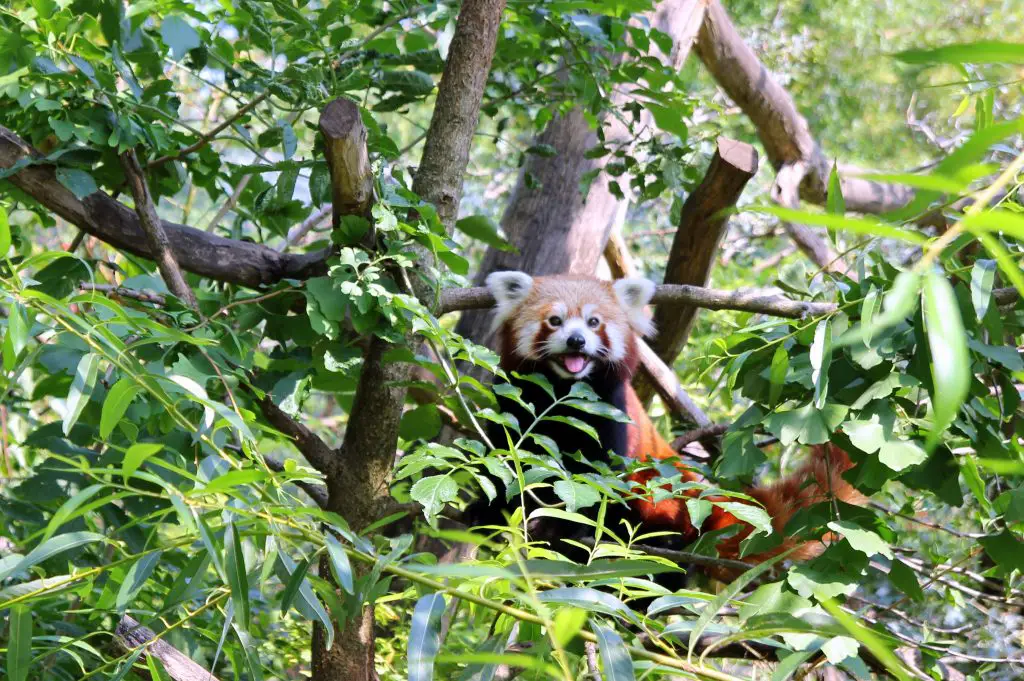No, Red Pandas are found in small, isolated mountain territories above 4,000 feet in China, Nepal, India, Bhutan, and Burma as well.
Red pandas are very cute animals that live in the higher mountains and live their whole life in the trees and eat the plants most of the time.

Most of the time, when not sleeping, you will find them jumping from one tree to another and this is what they do during the whole day.
Pandas belong to the Carnivora order of animals. this means that originally, they used to eat meat and vegetables as well.
Animals in this order are descendants of ancient creatures with a primarily meat-based diet. Many retained characteristics of carnivores including sharp teeth meant for shredding through flesh and tearing meat.
Also, read our article on what Red Pandas Eat
There are a lot of pandas like red pandas that have adapted themselves according to the environment. They started adapting new things and especially red pandas have adapted to a specialized plant-based diet composed mainly of bamboo.
Daily they eat food that consists of 20-30% of their body weight. Mostly red pandas eat around two to four pounds, or we can say around 1 to 2 kg of bamboo leaf tips and shoots.
They have molars and large skulls which makes the chewing process easier. They also have chewing muscles and strong jaws which makes the chewing process easy.
So, The Question Is Do Red Pandas Only Live in China?
Well, surprisingly red pandas’ fossils have been discovered from North America as far back as 5 million years.
Now Red Pandas are found in other territories aswell and small, isolated mountain territories above 4,000 feet in China, Nepal, India, Bhutan, and Burma as well.
So, they are not only found in China but are widely spread in the Eastern Himalayas. They live in higher mountains, and they keep their balance with their tail while jumping. Most of their time is spent in the trees and red panda cinnamon red coat.
Are There Red Pandas In Japan?
Unfortunately, not, there, you cannot find the red or giant pandas in the forests of Japan. Both species of pandas (red and giant pandas) can only be found in certain areas of the world and if we talk about Japan then it is not one of them.
There you will find or see the red pandas in the zoos.
They can be found in China, Myanmar, Yunnan. One big reason for being in these areas is that they can find a large number of bamboo trees there.
Japan is not one of those areas where they can find their diet and peaceful environment as well. Due to industrial development red pandas have been pushed away from the forests as the forests are being cut down every day. This is one of the reasons why they have been declared an endangered species.
Are There Red Pandas In India?
Yes In India, they are found in the Sikkim, western Arunachal Pradesh Darjeeling district of west Bangla, and the parts of Meghalaya.
Due to the marking of red pandas as endangered species, red pandas have the highest legal protection at par with the other threatened species.
In the Sikkim state, the red panda is their state animal and people love being around red pandas because of their good and naughty nature.
So India and especially the Sikkim district is one of those areas where red pandas can live and eat in a peaceful environment. So, red pandas are found in India and are also present at higher altitudes.
Are Red Pandas Nocturnal and Do They Sleep Differently Depending on Their Habitat?
Red pandas sleep patterns can vary depending on their habitat. These adorable creatures are primarily crepuscular, meaning they are active during dawn and dusk. However, they do have a tendency to be more active during the night in areas with more human disturbance. In the wild, red pandas build nests in tree hollows, branches, or dense foliage to rest and sleep during the day.
What Climate Do Red Pandas Live In?
Red pandas love to live in the cozy and peaceful environment. They are very solitary animals who do not like being around anyone.
They make their dens in those areas where there is no one in a peaceful environment where there is no animal or human as well.
If we talk about the climate then they can easily survive in a moderate climate where the temperature is not too cold or hot.
They are very cool and cute animals who are being liked by everyone else. For saving and protection, we should also put some efforts.












